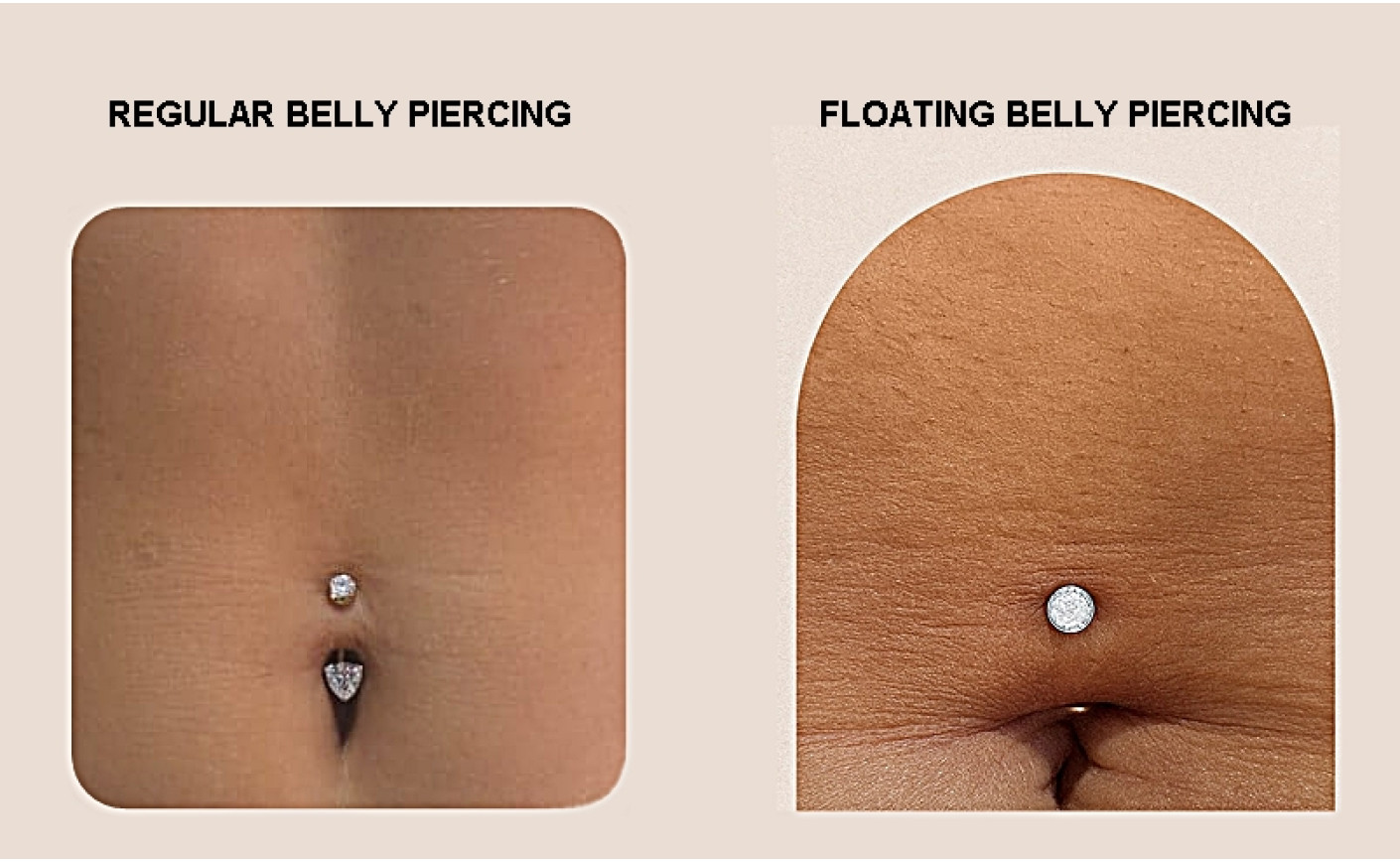Floating Belly Piercings: The Smarter, Safer, and More Beautiful Choice

Introduction: Why Floating Belly Piercings Are Taking Over
Belly piercings have been a timeless body art trend for decades. But not every belly button is the same, and not every piercing heals the same way. While the traditional navel piercing remains popular, the floating belly piercing has become a better alternative for many clients due to its placement, healing process, and aesthetic appeal.
In this detailed blog, we’ll cover why floating belly piercings are often superior to regular belly piercings, why they heal faster, how they look better, and which belly anatomies are most suitable for them.
What Is a Floating Belly Piercing?
A floating belly piercing is a type of navel piercing placed deeper than a traditional belly piercing. Instead of both jewelry ends being visible (like in a classic piercing with two balls), the flat disc end sits deep inside the navel fold, while the decorative stone is positioned on the outside, “floating” above the skin.
Jewelry Used
- Curved barbell
- Stone/decoration at the top (the part you see on the surface)
- Flat disc at the bottom (hidden inside the fold, preventing irritation)
This unique design gives the jewelry a sleek, elevated look while also reducing many of the common healing issues seen with regular belly piercings.
Why Floating Piercings Heal Faster
Healing time is one of the biggest factors when choosing a piercing. Floating piercings often heal more smoothly than traditional ones because of their deeper placement and jewelry design.
Key Healing Advantages:
1. Flat Disc Comfort
- The flat disc inside the navel reduces pressure and friction compared to a round ball.
- Less irritation = better tissue repair.
2. Stable Curved Barbell
- Designed to move less than traditional barbells.
- Reduces trauma caused by twisting or snagging.
3. Lower Sweat & Bacteria Build-Up
- Traditional piercings often sit where sweat, oil, and bacteria collect.
- Floating piercings are placed deeper, avoiding constant exposure to contaminants.
4.Reduced Risk of Rejection
- The deeper placement allows more skin to anchor the jewelry, lowering the chance of migration or rejection.
Healing time for floating piercings: Average 4–6 months (compared to 6–12 months for regular piercings).
Why Floating Belly Piercings Look Better
Style matters — and floating piercings win here too.
- Visible Jewelry Design: The decorative top sits prominently above the skin, making it eye-catching.
- Cleaner Aesthetic: Unlike traditional piercings, the jewelry doesn’t “sink” inside the navel.
- Jewelry Options: Crystals, gems, and decorative tops shine more when they sit on the surface.
- Balanced Look: Especially flattering for shallow navels, where regular piercings may look uneven or hidden.
This makes floating piercings especially popular for people who love crop tops, swimwear, and photoshoots.
Belly Anatomy: Who Is the Best Candidate?
Not everyone’s belly button is suited for a traditional piercing, which is where floating piercings become a perfect alternative.
Ideal Anatomy for Floating Piercings
- Shallow Navels: If your belly button doesn’t have a deep fold, a regular piercing won’t sit right.
- Tight Skin Tissue: People with firm abdominal skin heal better with deeper placements.
- Active Individuals: Gym-goers or athletes benefit because floating piercings move less and irritate less.
Less Ideal Candidates
- People with excess belly folds where jewelry may still press.
- Those with scar tissue or rejected piercings in the area (consultation required).
Floating vs. Traditional Belly Piercings: A Comparison
| Feature | Floating Piercing | Traditional Piercing |
|---|---|---|
| Jewelry Type | Curved barbell (stone on top, flat disc inside) | Curved barbell (ball on both ends) |
| Placement | Deeper inside navel fold | More external |
| Healing Time | Faster (4–6 months avg.) | Slower (6–12 months avg.) |
| Comfort | High – flat disc reduces irritation | Moderate – round ball causes friction |
| Aesthetic Look | Jewelry floats & stands out | Jewelry sinks into fold |
| Best for Anatomy | Shallow or tight navels | Deep navels with strong fold |
| Rejection Risk | Lower | Higher (especially for shallow navels) |
Aftercare for Floating Belly Piercings
Even with faster healing, aftercare is essential.
- Clean with Saline twice a day.
- Avoid Tight Clothing (like dresses or waistbands pressing on the piercing).
- No Twisting or Playing with Jewelry.
- Avoid Swimming Pools in early healing stages.
- Downsize Jewelry once swelling reduces (after 4–6 weeks).
Conclusion: Why Floating Piercings Are the Future
Floating belly piercings are not just a trend — they are a safer, smarter, and more stylish alternative to traditional navel piercings.
- They heal faster.
- They look more elegant.
- They are better suited to a wider range of belly anatomies.
If you’re considering a belly piercing, ask your piercer if a floating belly piercing is right for you. It may just be the perfect way to combine beauty with a smooth healing journey.

